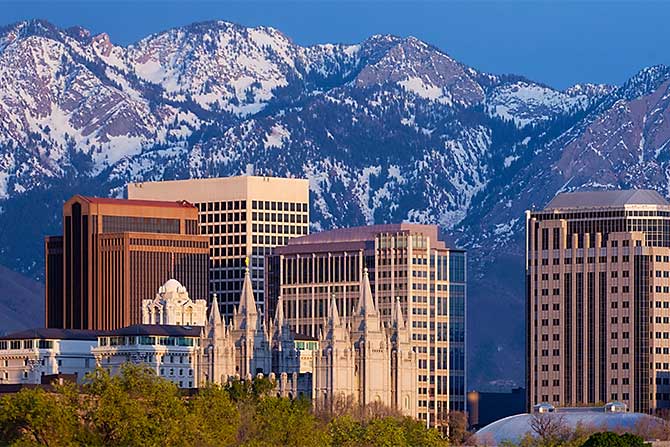As Utah’s economy remains strong and its population boom continues, sustainable development becomes both more important and more complex than ever in the face of policy shifts and political pressure. This year, Utah lawmakers introduced several energy and environmental bills that revealed where the state might be heading, and why those of us working in the built environment should be paying close attention.
Among the most significant bills to pass was SB 132 — Electricity Amendments, which allows large energy users such as data centers to bypass traditional utility regulation and purchase power directly from energy producers. While this sounds like market flexibility, critics argue it creates an uneven playing field and opens the door for corporations to pursue cheaper fossil fuels without public oversight, especially considering that this bill was heavily supported by Meta and other energy mega users.
HEAL Utah, an environmental watchdog group, raised concerns that SB 132 “erodes the role of the Public Service Commission, undermines planning for carbon reduction, and prioritizes corporate energy access over consumer equity.”
For the design community, this means potential shifts in energy sourcing for large developments, and a growing need for architects and engineers to advocate for renewable energy procurement and transparency during early planning phases. With Utah already sourcing nearly 60% of its electricity from coal and natural gas, the pressure is on to shift demand toward renewables, not away from them, as this also has implications for ongoing air quality issues.
HB 157 — Energy Education Amendments also passed this year, directing the Utah Office of Energy Development to create K-12 curricula and workforce pathways that align with the state’s energy policy.
Supporters say this will prepare students for the future economy. However, policy analysts caution that without explicit guardrails, it could become a platform for promoting fossil fuel industries over climate science and renewable innovation. The bill requires the establishment of a task force including industry stakeholders. While it includes representatives from the oil, gas and coal industries, renewable energy experts were omitted from the list.
This matters for the AEC industry. It’s the responsibility of architects and engineers to design high-quality buildings and building systems that are both operationally more efficient and less expensive, as well as adaptable to future demands. The narratives we teach our children today will shape the architects and designers of the future. As stewards of the built environment, architects must advocate for balanced, evidence-based education that reflects the urgent need to build for a low-carbon future.
Although it failed to pass, HB 241 — Solar Power Plant Amendments could be back on the table in some form in the future. The bill proposed major restrictions on where utility-scale solar could be built, including limiting state incentives for projects located on high-quality agricultural or grazing land. It also required strict decommissioning plans and consultation with wildlife authorities.
While the land stewardship and wildlife protection components of the bill are encouraging, the bill was criticized for creating red tape that would slow Utah’s clean energy transition. According to the U.S. Energy Information Administration, Utah’s solar capacity increased by nearly 25% in the last five years. Creating additional hurdles for solar development could limit its positive economic and environmental impact.
Design professionals working on master-planned communities or large developments should watch for the return of this legislation in 2026. It reflects growing public discomfort with the scale and visual impact of renewable infrastructure, a challenge architects are equipped to address through thoughtful design, landscape integration and community dialogue.
Passed into law this year, HB 85 — Environmental Permitting Modifications streamlines how permits are processed for industrial and energy projects. While efficiency is welcome, the bill also limits the scope of environmental review in certain cases.
This shift could speed up construction timelines for projects ranging from manufacturing to energy infrastructure, but it raises red flags for those concerned about transparency, environmental justice and public input. For architects, it underscores the need to conduct internal sustainability and health impact assessments even when policy doesn’t require them.
With climate resilience becoming a standard in high-performance building, even to the point where some insurance companies require it, design professionals can look beyond legal requirements to deliver even better facilities.
Some of the most crucial environmental issues in Utah were left largely untouched by successful legislation in 2025. Bills that would have tackled air quality and transportation emissions, or provided incentives for low-water landscaping failed to gain traction. And issues surrounding the shrinking Great Salt Lake were almost completely ignored.
One example is HB 499 S2 — Department of Environmental Quality Amendments, which proposed reforms to the Air Quality Board and updated water heater emissions standards, but they were not passed. This leaves critical gaps in addressing Utah’s chronic air pollution, which is a widely known problem that affects everything from sitting decisions to indoor air quality design strategies.
Utah also continues to lack strong incentives for water-wise development, even as the Great Salt Lake shrinks to historic lows. With architects increasingly called upon to design for drought resilience, the absence of state-level policy support presents a barrier to scaling sustainable landscape design.
The story of Utah’s 2025 legislative session is not one of outright climate denial or neglect; however, it does leave doubt about the quality of life we are creating for future generations. Energy education, utility policy and permitting are being reshaped, but often in ways that favor legacy industries or corporate interests.
Whether through clean energy sourcing, adaptive reuse or community advocacy, AIA members must stay engaged in the process of sustainable development, both on the design side and on the policy side. The built environment can either cling to practices that no longer provide the best outcomes for the most people, or lead the way into a resilient, sustainable future. Let’s choose to lead.
Sources
Utah State Legislature (le.utah.gov), https://le.utah.gov/~2025/bills/static/HB0157.html and https://le.utah.gov/~2025/bills/static/HB0241.html
HEAL Utah 2025 Legislative Recap, https://www.healutah.org/2025-legislative-recap/
U.S. Energy Information Administration, https://www.eia.gov/state/?sid=UT
Utah Office of Energy Development, https://energy.utah.gov/








